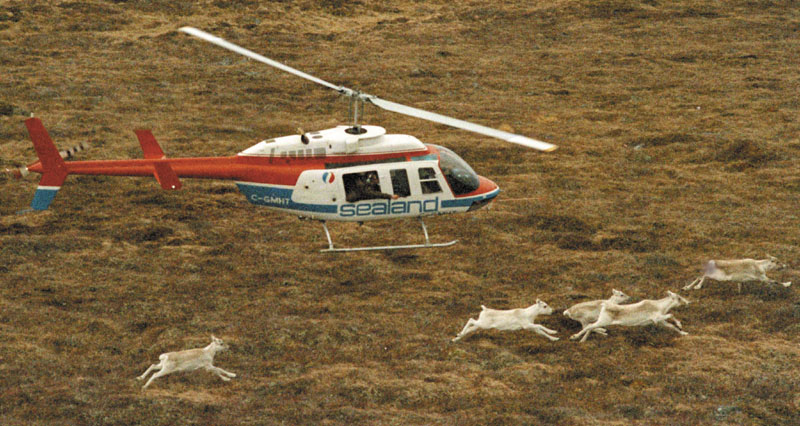AUGUSTA — Helicopters bore down on the fleeting caribou herd as sharp-eyed biologists took careful aim with their tranquilizer guns. Over a couple of days, 27 of the animals would be dropped and airlifted to the edge of a southeastern Newfoundland barren and prepared for a nearly 800-mile trip to Maine.
But leaders of the well-intentioned expedition aimed at restoring the caribou in Maine would soon see things go very badly.
“We had no way of knowing it, but we were committed on a collision course with one of the most violent winter storms along the northeast American and maritime coasts in years,” Paul Fournier writes in his new book, “Tales from Misery Ridge,” published by Islandport Press. The book appears just shy of 25 years after the caribou roundup of December 1986.
The transplant odyssey is one of about a dozen true tales told by the lifelong outdoors enthusiast whose name was familiar to Mainers for two decades as the state Inland Fisheries and Wildlife Department spokesman. In that role, he related stories through the media of searches for lost hunters and hikers, bears terrorizing towns, eagles being restored and poachers being busted.
But Fournier, now 82, has more to tell, from his years as a bush pilot in the ’50s and sporting camp owner and guide, photographer, TV producer and freelance writer.
His story of flying solo over Maine’s wilds with hardly any gas in the tank while earning his pilot’s credentials tells a lot about the primitive state of aeronautics in the 1950s, while giving the reader a bit of a thrill ride.
Fournier starts the book by telling of his lifelong love for canoes, in which he paddled and poled the remotest streams to catch prize landlocked salmon and trout. He tells of a banker from Pennsylvania latching onto the catch of his life — a 9-pound salmon — that would have become a trophy over his fireplace had the cook not found it and served it in a chowder.
And there’s the 300-mile trek through the Allagash region in 1961 to test run some new snowmobiles. They were crude and awkward by today’s standards, with cruising speeds of a mere 20 mph, but good enough to access a northern ice-fishing heaven. In one spot, a 6-inch auger hole had to be doubled to yank out a nearly 3-foot trout that weighed 10 pounds.
“Over the years, lots of people have said, ‘Why don’t you write a book?”‘ Fournier, who has trouble hearing on the phone, wrote in an e-mail. “Well, I finally done it. It just seemed that I have been blessed with so many wonderful experiences, and hoped to share my love and compassion for Maine, its wildlands, and the creatures that inhabit them.”
His most unforgettable experience goes back to the caribou roundup, a project intended to restore the creature that was once so abundant in Maine that a city was named for it. An attempt in 1963 had failed to bring back the long-gone caribou, and leaders of the privately funded effort set out again in 1986 to succeed. As a fish and game spokesman as well as still photo and video photographer, Fournier was deeply involved, including driving a car that followed the cattle truck hauling the caribou to Maine after the roundup.
A ferocious snowstorm clobbered Canada, making for a treacherous ride over unplowed roads and whipping up 60-foot seas and 120-mph, hurricane-force wind blasts for the ferry ride from Newfoundland to the mainland. The violent conditions not only damaged the ship, but also killed two of the caribou and left the survivors, some of which sustained injuries, heavily stressed.
Even after the first storm subsided, the drivers were met by a second nor’easter, this one in New Brunswick. Again, roadways remained unplowed during the storm and the wet, heavy snow piled up fast, making driving difficult, Fournier writes.
Once back in Maine, the herd was penned near the state university at Orono so offspring could be produced. Finally the animals were released into the state’s wilds, only to gradually die off from disease and predators.
Fournier calls the “ill-fated caribou transfer” one of the book’s highlights, but he said he feels most strongly about the loss of wild trout habitat to which he devotes a chapter. He sees his most upbeat story the first efforts to restore bald eagles in Maine, which was done with “remarkable success.”
He writes with special affection about the place that inspired the book’s title. From the mid-’50s to mid-’60s, Fournier ran his camps within sight of Misery Ridge, in the unincorporated Misery Township west of Moosehead Lake. Home to moose, deer and bears and virtually no humans, the place is anything but what its name suggests in the author’s view. Besides, Fournier notes, the name Misery is a corruption of the Abenaki word for “many things,” as in many small ponds that dot the area.
“The memory of Misery Ridge’s serenity and steadfastness has helped guide me along life’s path,” Fournier writes.
Send questions/comments to the editors.



Success. Please wait for the page to reload. If the page does not reload within 5 seconds, please refresh the page.
Enter your email and password to access comments.
Hi, to comment on stories you must . This profile is in addition to your subscription and website login.
Already have a commenting profile? .
Invalid username/password.
Please check your email to confirm and complete your registration.
Only subscribers are eligible to post comments. Please subscribe or login first for digital access. Here’s why.
Use the form below to reset your password. When you've submitted your account email, we will send an email with a reset code.